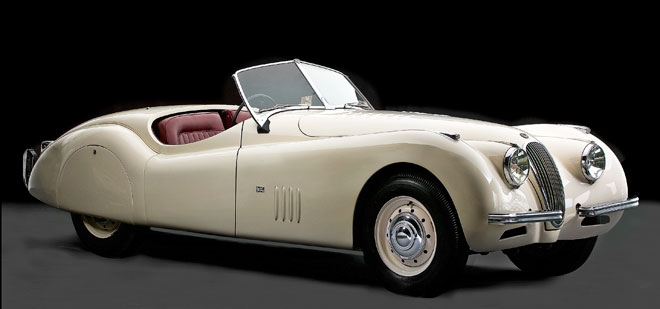Chassis Number: 660017
The few alloy-bodied cars were essentially prototypes sold to raise desperately needed foreign currency for the factory design team
During the difficult period after World War II, Jaguar Cars became the United Kingdom’s biggest U.S.-dollar earner, thanks in no small measure to the success of its XK120 sports car. Ironically, the XK120’s creation had only come about because delays in developing the Mk VII saloon had forced William Lyons to find an alternative method of bringing the new XK 6-cylinder engine to public attention. Conceived and constructed in a few months, the XK120 debuted at the 1948 Earls Court Motor Show, where the radical lines, potential performance, and bargain price of the roadster were the sensation of the show.
Lyons only intended to produce 200 units of the XK120, so the resulting demand for what was then the world’s fastest production car took Jaguar by surprise. It was immediately obvious that the ash-framed alloy coachwork—hand built in the best vintage tradition—would have to go and the XK120 was re-engineered in steel after 240 cars had been completed.
Its stunning appearance notwithstanding, the XK120 was conventional enough beneath the skin. Lyons shortened and narrowed the frame from the Mk V saloon, with its wishbones and torsion bars, independent front suspension, a live rear axle, and drum brakes all around. Lyons himself designed the body, one of the most beautiful shapes ever to grace an automobile. It was coachbuilt, aluminum sheet over ash framing, because that was the quickest way to create the low-volume car.
The car’s heart was, of course, the fabulous XK engine. Conceived, according to the mythology, by William Lyons and his engineers during the long night-time fire watches at the Coventry Works, and intended for Jaguar’s post-war saloon, the 3.4-liter six embodied the best of modern design. The engine boasted twin overhead camshafts running in an aluminum-alloy cylinder head, seven main bearings, and a maximum output of 160 horsepower. When installed in the lightweight XK120, the result was a car with a phenomenal power-to-weight ratio, easily capable—even in street trim—of making the eponymous 120 mph.
The 17th right-hand-drive XK120 to leave the factory, “660017” was completed in cream livery with two-tone biscuit and cream upholstery. Terry McGrath and John Elmgreen, in their definitive book, The Jaguar XK120 in the Southern Hemisphere, confirm the car was dispatched to Brylaws of Sydney on December 7, 1949 on the “Willesden” and was first sold to Roland Desborough Bright of Edgecliff, New South Wales, on February 16, 1950. The car was owned and raced by Paul Roberts of Wollongong in 1953. Around this period it was fitted with some C-type parts—including the cylinder head, sand-cast SU carburetors and exhaust manifold—from “XKC037,” the ex-Frank Gardner car.
Sold to Les and Col Merrick by 1965, the car changed hands several times in the late 1960s, passing via Rowley Motors to Robert Kennedy of Sydney, then to Dave Handyside of Richmond Royal Australian Air Force Base, and finally to Simon Atkinson in Paddington, NSW.
By the 1970s, the old warhorse had begun a new career in historic racing, first raced by Bryan Allart of Double Bay, then by the late Hon. John Dawson-Damer. Contemporary photographs of the Jaguar depict it looking a little worse for wear and driven hard by Dawson-Damer. Following some damage sustained at Amaroo Park in 1979, the car was retired from competition and treated to a thorough restoration and refinishing in the original color scheme. Most of the period modifications were left intact, including the louvers in the bonnet and wings, two-inch carburetors, hotter cams and close-ratio Moss gearbox.
Dawson-Damer lost his life in tragic circumstances at the Goodwood Festival of Speed in 2000 in his beloved Lotus F1 car, but the Jaguar has remained with the family ever since.
Presented in first-class condition today, 660017 is one of the few alloy-bodied XK120 roadsters to remain in Australia. Enjoying single-family ownership for the last 33 years, possessing period race history and eligible for many of the greatest events, including the Goodwood Revival, this car is without doubt one of the more significant Jaguars to come on the market in recent years. In its current condition, 660017 would be equally at home on the concours lawn or on the racetrack, where it should prove one of the faster XKs.

